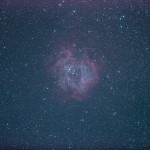A result from Saturday night. About an hour of integration all told… Good color, very nice stars, good detail. While encouraging, I really need more time on this one, there is too much noise in the fainter regions of the nebula. I can get more data and add it to the stack to continue to improve the result. From up on the mountain I should be able to use longer exposures with darker skies. Colder conditions will reduce the dark current in the camera, also aiding in longer exposures.

The Rosette Nebula is a large star forming region just east of Orion in the constellation of Monocerus. It is quite large, the main body seen in the photograph is well over a degree across. The dark region in the center is about the size of the Full Moon


